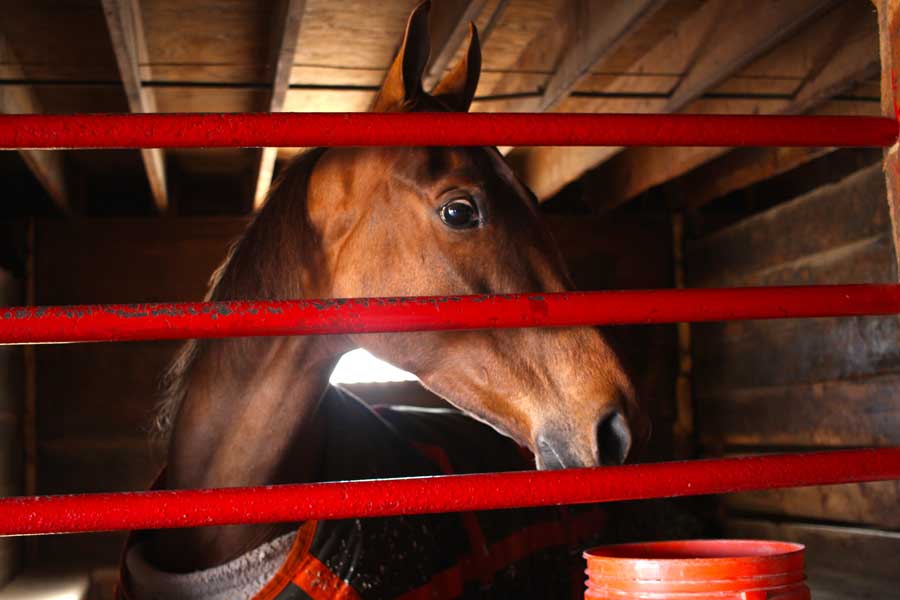How to Get Your Horse Spring-Ready March 16 2015
 |
As show season has already begun in the south, horse owners who have taken their time prepping their show ring teammate need to get to work! While it may be tempting to just saddle up and start riding, it's as (if not more) essential to get a horse ready for horse show prep as it is to get ready yourself for show season. If you had a few months off for winter (and let's face it, who hasn't), you wouldn’t start by running a marathon either. Here are some tips to help to get horses ready for a safe, ease into fitness for show season.
Proper Winter Nutrition
Horses that are able to graze throughout the winter may be able to maintain a more steady body weight than those with unsatisfactory pasture conditions (like those of us that live up north and have a pasture of ice). Hay helps to maintain a healthy body weight and suits a horse’s natural “grazing” digestive process, but grain supplements may also be needed to give your show horse the extra umph they need to get to work. Horse owners that have the ability to monitor their horse's weight and energy levels can adjust their equine bff’s feed for optimum health. Getting the right nutrition over the winter is a must to ensure that your show horse is ready for the physical demands of getting in shape and staying that way.
Getting Your Horse's Hooves Ready for Spring
If you have your horse at a training barn, it’s likely that their shoes have stayed on over winter, they have been working (though lightly) and they are pretty much ready to go, but some give their show horses a full on vacation; pull their shoes and send them outside to enjoy a well deserved rest. If your four legged friend is in the latter category, it’s important to be aware of what has been happening to their feet while on winter break. While it is a fact that hooves grow at a slower rate during the winter, it is important to note that hooves still continue growing. Cracks and breakage can occur throughout the winter, and bacteria can cause conditions like thrush if hooves are not cleaned on a daily basis. Making sure that hooves get the moisture that they need by having horses stand in a wet or muddy area is recommended to prevent breakage, or supplement the lack of moisture with a regular hoof greasing. Having horses' feet properly trimmed and assessed for problems by a farrier well before you pop their show shoes back on can help you fight off issues that could appear mid-season.
Get Your Spring Shots
Spring is a time to focus on the health of horses before they are under the same roof as so many other horses and expected to perform in tip top shape! Making sure that horses are current on their vaccinations is part of taking care of their health and ensuring they aren’t a part of spreading equine illnesses when you head off to a show. While horses need vaccines for protection against life-threatening illnesses, it is possible for the animals to have a reaction to their shots. This can even happen in horses that have never had a negative reaction before, so owners should be prepared to give their horses a few days to recover after being given immunizations. Even if horses do not have a reaction to vaccines, the medication that is being administered can cause lethargy. AND DON’T FORGET YOUR COGGINS!
Start out Slow
Horses get used to being on their own over the winter, and being exposed to the spring weather may make them feel playful (we’ve all experience the joyous - and horrifying - leaps of spring joy at the first working session of spring). If you have the arena to yourself, turning your horse our in the ring with equipment/tack on before riding them can help them get used to the added weight after a long winter. If that isn’t an option, lunge them with their tack on before getting on. Letting them get some of their energy out is also a tool to help them focus on the task at hand. Be prepared for the first rides of the spring to be short and more challenging than normal.
Getting horses ready for show season is a matter of focusing on health, and easing them back into their routine. Be sure to evaluate the condition of tack and equipment before spring weather arrives, and be patient before heading out on the trail or in the ring to ensure that the process is stress-free, both for you and for your horse.

